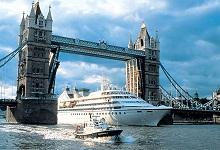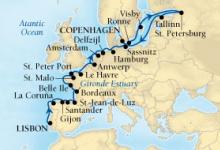Recently Viewed Cruises
- Pride, Atlantic & Baltic Capitals ex Lisbon to CopenhagenAdd to favourites
- Pacifica, Scandi Russia Cruise ex Kiel RoundtripAdd to favourites
- Vision, St Petersburg & Baltic ex Copenhagen RoundtripAdd to favourites
- Magnifica, Germany Sweden Estonia Russia Denmark Netherlands ex Hamburg ReturnAdd to favourites
- Magnifica, To Russia with Love ex Hamburg ReturnAdd to favourites
- Catch up on Cruising: Latest cruise news in bite size
- Royal Caribbean International raises the bar
- Classy Astor fills gap in market
- Oceanic Discoverer
- Ab Fab Oosterdam
- Frequently Asked Questions
-
Pride, Atlantic & Baltic Capitals ex Lisbon to Copenhagen
Nights 28 Ship Seabourn Pride Star Rating 
Departs Lisbon, Portugal Sailing 2013: 13 May Ports of Call Lisbon, La Coruna, Gijon, Santander, St Jean de Luz, Bordeaux, Le Palais, St Malo More St. Peter Port, Le Havre, Antwerp, Amsterdam, Groningen, Hamburg, Kiel Canal, Ronne, Visby Sweden, St Petersburg, Tallinn, Sassnitz, Copenhagen Please enquire about this cruise for pricing.


28 Night Cruise sailing from Lisbon to Copenhagen aboard Seabourn Pride.
The ship that started it all inspired one critic to declare that "Seabourn is in a class by itself." And in 1988, when the sleek, 10,000-ton Pride emerged from the Schichau Seebeckwerft shipyard in Bremerhaven, Germany, that was literally true.
At that time, most ships of Pride's size (and there were more then than now) carried more than 400 guests. Seabourn Pride, christened by Ambassador Shirley Temple Black, topped out at half that many.
The idea that every guest sailed in an expansive, ocean-view suite was revolutionary. The concept of open-seating dining accommodating all guests was exceptional. And the notion of including nearly everything for the cost of the fare was a rare thing as well. But the most important element of the Seabourn experience, to founding president Warren S. Titus, was the unparalleled level of personalized service provided to guests.
Hand-picked staff, recruited from the finest European hospitality schools and hostelries, are re-trained and managed according to the philosophy that every request is a golden opportunity to create delight, that the unexpected pleasure is what truly makes an experience memorable, and that the rendering of the very best service is a product of professional pride, not influenced by the expectation of a gratuity.
That remains a core value of all Seabourn ships today. By a trick of history, Seabourn Pride and its sisters remain as exceptional today as they were when launched - in a class by themselves.
Highlights of this cruise:
Lisbon
The great period of "the Discoveries" accounted for phenomenal wealth brought back from India, Africa and Brazil by the great Portuguese navigators. Gold, jewels, ivory, porcelain and spices helped finance grand new buildings and impressive monuments in Lisbon, the country's capital city. As you sail up the Tagus River, be on deck to admire Lisbon's panorama and see some of the great monuments lining the river. Lisbon is one of Europe's smallest capital cities but considered by many visitors to be one of the most likeable. Spread over a string of seven hills, the city offers a variety of faces, including a refreshing no-frills simplicity reflected in the people as they go unhurriedly through their day enjoying a hearty and delicious cuisine accompanied by the country's excellent wines.
Gijon
This ancient port city on the green Atlantic coast of Spain has a history of some 3,000 years. From its humble beginnings the city has grown to become an important port city in Spain. Its old historic fishing village Cimadevilla with its picturesque cobble stoned streets and old-world architecture remains today its main tourist attraction.
Santander
Santander is a resort that from 1913 to 1930 became a royal residence after city officials presented an English-style Magdalena Palace to Alfonso XIII and his queen, Victoria Eugenia. An ancient city, Santander was damaged by a 1941 fire, which destroyed the old quarter and most of its dwellings. It was rebuilt along original lines, with wide boulevards, a waterfront promenade, sidewalk cafes, shops, restaurants and hotels. Santander is an education center, with courses offered at the once-royal palace, now the Menendez Pelayo International University. Students and teachers from North America and Europe come here to study and enjoy the area.
Bordeaux
Bordeaux is the starting point for many exciting excursions into the surrounding wine country. The patricians of Bordeaux have always been merchants and shipbuilders. Under the Romans the city had a flourishing trade with Spain and Britain. In 1154, as a part of the dowry of Eleanor of Aquitaine, it became English and remained so until 1453. In the 18th century, Bordeaux prospered from the slave trade, and later in commerce with French colonies in Africa. Since Roman times the quality of the region's vines and wines has been zealously maintained.
St Malo
Saint-Malo, known as the Corsaires city, is situated at the Cote d'Emeraude on the Rance River in the north-east of Brittany. The city's name stems from the Welsh Monk MacLow Saint-Malo. The city, which has been a seaward fortress since the end of the 17th century, had one of the most important ports in France. The mighty fortifications and ramparts were designed by Simon Garangeau, a disciple of the famous Vauban. Founded in the 6th century as a monastic settlement, the city retains much of its august, historic and dignified veneer. Saint-Malo is now a city of granite rebuilt after WWII to its original style and skyline. Nearby is the island monastery of Mont St. Michel, founded in 708. A focal point for tourists and the faithful alike, early pilgrims risked their lives crossing the treacherous mud flats to reach this site. Now a dam is needed to keep Mont St. Michel's flats from silting up.
Le Havre
Originally built in 1517 on the orders of King Francois I, Le Havre, (the Harbor) grew to become France's second busiest port. Prior to World War II, Le Havre was home port to many of the day's great luxury liners, including the France, the Normandie and Ile de France. Virtually destroyed by bombing raids during the war, the present city is perhaps most notable for being the vision of a single architect, Auguste Perret, during its reconstruction between 1946 and 1964. Two buildings of particular note are the stark Hotel de Ville and the towering church of St. Joseph, with its 99-meter bell tower. The Musee des Beaux-Arts, near the port, features a room devoted to the works of native son Raoul Duffy in addition to a fine collection of 19th and 20th-century French artists.
Brussels
The Belgian capital is also the capital of the European Union and the headquarters of the North Atlantic Treaty Organization (NATO). It is one of Europe's most important cities for business, politics and culture. The city possesses some 80 museums and, as the birthplace of a number of Europe's most famous comic books, even has a Comic Book Route leading to exterior murals of familiar characters such as Tintin. One notable architectural site is the elaborate Guildhalls of Grand Place. Nearby Antwerp is famous for the World Diamond Centre, though which flow virtually all of the gem quality diamonds in the trade. Antwerp's Central Station is also a gem, for connoisseurs of Golden Age railway architecture.
Amsterdam
The delightfully attractive city of Amsterdam is home to many of the world's great art treasures, and is a major center of the glamorous diamond trade as well. Unique architectural styles of the past blend with superb modern structures, and the web of curved and straight canals makes the city as easy to traverse by water as by land. The hospitality of the local people has been remarked upon by generations of travelers, and the Dutch's respect for and tolerance of the beliefs of others has attracted refugees from around the world for centuries.
Hamburg
The residents of Hamburg have retained the independent spirit which earned this autonomous commercial center its 'Free City' designation in the Middle Ages. One of Germany's principal ports, Hamburg is surrounded by enormous dock areas and the gaudy, licentious Reeperbahn (which translates loosely to 'Anchorage of Joy') is fully prepared to offer every form of entertainment to the world's sailors. The vaudeville acts at the Hansa-Theater are bright and clever (and language is no barrier). The Kunsthalle (art museum) boasts an outstanding collection of 16th- and 20th-century masterpieces, and the Renaissance Rathaus (city hall) sits atop some 4,000 piles driven into marshy ground proving that the engineers of Hamburg have been skilled and imaginative for centuries.
Visby
This delightful hilly town, boasting medieval houses and ruined fortifications, is the island of Gotland's capital city. Due to its gentle climate an abundance of roses bloom here, even as late as November, marking Visby as "The City of Roses." In its heyday, Visby was one of the richest trading centers in northern Europe. Remains of the medieval city walls are considered to be among the best-preserved in Europe. Additional points of interest include the cathedral, one of the town's 17 medieval churches still in use today; the Old Apothecary, a late medieval four-story merchant's house; and the Fornsal Museum with an interesting exhibit of medieval artwork, hordes of silver from Viking times, and impressive picture stones that predate the Viking rune stones. Sweden's main holiday island offers wide sandy beaches, wild cliff formations, and verdant sheepfarming country and glades in which 35 different varieties of wild orchids thrive, attracting botanists from around the world. There are also a hundred more churches dating from Gotland's great commercial era scattered across the island which are still in use today.
St Petersburg
Founded in 1703 by Peter the Great, Russia's second largest city and principal Baltic port contains a tsar's ransom in architecture, palaces and art treasures. Once the capital of Imperial Russia and playground of Russia's elite, the city's name was changed following the 1917 revolution to Petrograd, then Leningrad, before resuming its original name in 1991. St. Petersburg is patterned after Western capitals with canals reminiscent of Venice, a grand boulevard that evokes Paris and a spirit that is uniquely Russian.
Copenhagen
Denmark's capital is arguably one of the world's best-loved cities, and certainly the liveliest of all the Scandinavian capitals. It is a gracious and comfortable place, with a decidedly friendly, hospitable and fun-loving atmosphere. If there is such a thing as a cozy city, Copenhagen is it. From the lingering memory of the tales of Hans Christian Andersen to the colored lights of Tivoli Gardens, there is a delightful ambience that surrounds the visitor everywhere. Tidy, narrow streets are lined with tempting restaurants and cafes, and the pedestrian-only Stroget abounds with stylish shops. The spirited Copenhageners are imaginative and unconventional and exude a "do-what-you-want" philosophy that embraces and respects almost all aspects of life. Every friendly Dane you meet further illustrates the city's motto "Wonderful, wonderful, Copenhagen."





